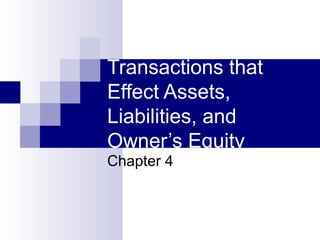
Chapter 4 transactions that effect assets, liabilities, and
- 1. Transactions that Effect Assets, Liabilities, and Owner’s Equity Chapter 4
- 2. Exploring the Real World of Business Review the American Airlines Web Site www.aa.com **************** Name at least three business transactions that would affect the assets and liabilities of American Airlines.
- 3. Accounts and the Double-Entry Accounting System Section 1
- 4. You Will Learn How to use T accounts Why you need a ledger The rule of debit and credit
- 5. Key Terms Ledger Chart of accounts T account Double-entry accounting Credit Debit Normal balance
- 6. The Account Ledger – referred to as keeping the books Grouping accounts makes information easy to find. When financial statements are needed information is taken from the ledger and organized into reports
- 7. The Chart of Accounts List of all the accounts and their assigned numbers Assets accounts begin with 1 Liability accounts begin with 2 Owner’s equity accounts begins with 3 Revenue accounts begins with 4. Expense accounts begin with 5.
- 9. Double-Entry Accounting A system of recordkeeping in which each business transaction affects at least two accounts
- 10. T Accounts T-accounts shows the dollar increase or decrease in an account that is caused by a transaction The left side of the T accounts is always used for debit amounts (DR) The right side of the T accounts is always used for credit amounts (CR) The words debit and credit are simply the accountants terms for left and right.
- 11. T-Accounts Account Name Left Side Right Side Debit Side Credit Side Debit Credit
- 12. The Rules of Debit and Credit An account’s normal balance is always on the side used to record the increases to the account. Rules for Asset Accounts 1. An asset account is increased on the debit side (left side). 2. An asset account is decreased on the credit side (right side). 3. The normal balance for an asset is the increase side or debit side. Assets normally have debit balances.
- 13. The Rules of Debit and Credit Rules for Liability and Owner’s Capital Accounts 1. Liability an owner’s capital accounts are increased on the credit side (right side). 2. Liability and owners capital accounts are decreased on the debit side (left side). 3. The normal balance for liability and owner’s capital is the increase side, or credit side. Liability and owner’s capital normally have credit balances.
- 14. Check Your Understanding Please complete Thinking Critically Computing in the Business World Problem 4-1, page 77
- 15. Applying the Rules of Debit and Credit Section 2
- 16. You Will Learn How to analyze a transaction affecting assets, liabilities and owner’s equity.
- 18. Key Points For every transaction, total debits must equal total credits
- 19. Business Transactions 1. On October 1 Maria Sanchez took $25,000 from personal savings and deposited that amount to open a business checking account in the name of Roadrunner Delivery service 2. On October 2 Maria Sanchez took two telephones valued at $200 each from her home and transferred them to the business as office equipment. 3. On October 4 Roadrunner issued a check for $3,000 to buy a computer system.
- 20. Business Transaction 1. On October 9 Roadrunner bought a used truck on account from North Shore auto for $12,000. 2. On October 11Roadrunner sold on phone on account to Green Company for $200. 3. On October 12 Roadrunner mailed Check 102 for $350 as the first installment payment on the truck from North Shore Auto on October 9
- 21. Business Transaction On October 14, Roadrunner received and deposited a check for $200 from Green Company. The check is full payment for the telephone sold on account to Green Company on October 11.
- 22. A Matter of Ethics Software Piracy Imagine you’re a bookkeeper for an attorney who likes to use state of the art technology. The business just received the latest update on its Web site design software. You would like to use the software at home, so your assistant offers to make you a copy. Although you know that copyright laws protect software from unauthorized use, you figure that one little sale can’t hurt a multimillion dollar software company; besides, you’re not doing the actual copying.
- 23. A Matter of Ethics Ethical Decision Making What are the ethical issues? What are the alternatives? Who are the effected parties? How do the alternatives effective the parties? What would you do?
Editor's Notes
- The rules of debit and credit are the basis for entering transactions into the records of a business.
- An account is a location within the accounting system in which the increases and decreases in a specific asset, liability, or owner’s equity are recorded and stored. Whether a system is manual or electronic, accounts are stored in a ledger
- To keep track of its accounts a business develops a chart of accounts.
- An effective way to apply double-entry accounting is to use a T-account.
- Debits and credits are used to record the increase or decrease in each account affected by a business transaction. For each debit entry made in one account, a credit of an equal amount must be made in another account.
- You need to analyze transactions properly so that you record them correctly.